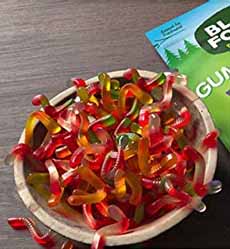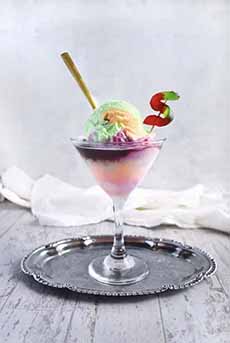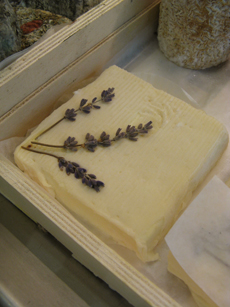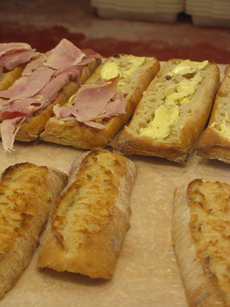|

[1] Gummy worms, invented by Trolli, are now made by a variety of producers (photo © Black Forest | Amazon).

[2] Not just kid stiff: a sophisticated sundae. Here’s the recipe (photo © Infinite Taste).

[3] What’s more fun than a blue frozen drink? One garnished with gummies! Here’s the recipe (photo © My Incredible Recipes).

[4] Dirt cake is a popular recipe that features gummy worms. Here’s the recipe for this one (photo © Food Network).
|
|
Today is National Gummy Worms Day. But not everybody can enjoy a juicy gummy worm.
That’s because many gummy candies are made with gelatin, an animal product that’s neither kosher nor vegetarian/vegan.
The traditional gummy candy is made with sugar, glucose syrup (more sugar), starch, flavoring, food color, citric acid and gelatin.
GUMMY CANDY HISTORY
The first gummy candies, Gummi Bears, were produced in 1922 by Haribo, a Bonn, Germany, confectioner.
Founder Hans Riegel invented the Dancing Bear, a fruit made in the shape of a bear. Why a bear?
In 19th-century Europe, it wasn’t uncommon to see dancing bears, skipping down the streets in parades and festivals. They were trained to skip, hop, whirl, twirl, and perform an array of tricks.
Riegel was inspired by these animal entertainers and felt that children would be attracted to bear-shaped candy.
In 1967 the Dancing Bears became Gummi Bears and spawned an entire zoo of gummi animals.
Worms are not zoo creatures, however, and Haribo did not invent the Gummi Worm.
Gummi Worms were introduced by another German gummi candy manufacturer, Trolli (named for forest trolls), in 1981. The U.S. Americanized “gummi” to “gummy.”
The boom in gummy popularity spawned versions that are organic, kosher, and halal. For the latter two, manufacturers have substituted pectin or starch for gelatin.
Goody Good Stuff is an all-natural gummy candy line that is made with a plant-derived gum.
It eliminates the need for animal-based gelatin while maintaining a smooth and clear consistency. There are no artificial colors or flavors and no possible allergens, such as gluten.
There are no worms, either. At this time, there are sweet and sour gummy candies in fruit, bear, and cola bottle shapes.
All of the products are vegetarian (some are vegan), kosher and halal. Here’s the company website.
THINGS TO DO WITH GUMMY CANDIES
Beyond snacking, bring out the gummies for parties:
Incorporate them into centerpiece decorations
Fill glass candy bowls
Garnish the rim of desert plates
Top cupcakes or cookies
Use as ice cream toppers
Make gummy fruit kabobs
Dip in chocolate for “gourmet” gummies
Decorate the rim of cocktails
Add to popcorn
Make gummy trail mix: gummies, M&Ms or Reese’s Pieces, nuts, pretzels and raisins or dried cherries
Gummy Worm Cake
Back to gummy worms: Make this easy dessert or snack recipe for “dirt cake” using Oreos, gummy worms, vanilla pudding and cream cheese.
It’s appealing to adults as well as kids—really.
Everyone can use a little food fun!
|







